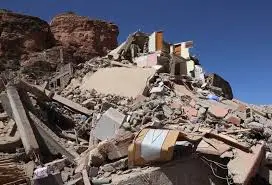
Myanmar Earthquake 2025: Causes, Impact, and Myths Explained
On March 28, 2025, a devastating 7.7-magnitude earthquake struck central Myanmar, resulting in widespread destruction, loss of life, and a global conversation about natural disaster prediction. This article provides a deep analysis of the earthquake’s causes, the extent of the damage, scientific perspectives, and the myths surrounding deep-sea fish sightings as omens of seismic activity.
The Science Behind the Myanmar Earthquake
Earthquakes occur due to the movement of tectonic plates beneath the Earth’s surface. Myanmar is located in a seismically active region, where the Indian plate pushes against the Eurasian plate, creating significant tectonic stress. The 7.7-magnitude earthquake on March 28 was caused by the release of accumulated stress along a major fault line, likely the Sagaing Fault, which runs through the country.
Why Did Buildings Collapse?

The earthquake led to the collapse of thousands of buildings, particularly in densely populated urban centers. Several factors contributed to the destruction:
- Poor Infrastructure – Many buildings in Myanmar, especially in rural areas, are not built to withstand strong earthquakes due to a lack of strict construction regulations.
- Soft Soil – Some affected regions were built on soft alluvial soil, which amplifies seismic waves, increasing the intensity of ground shaking.
- High Population Density – In cities, people were trapped under the debris of residential and commercial buildings, leading to a higher casualty count.
- Aftershocks – Multiple aftershocks, some as strong as 6.5 in magnitude, continued to weaken already damaged structures, causing further collapses.
Casualties and Humanitarian Impact
As of the latest reports, the earthquake has resulted in over 1,600 deaths, with thousands more injured. Rescue operations have been challenging due to damaged roads, communication breakdowns, and ongoing regional conflicts. Relief efforts are underway, with neighboring countries such as India, China, and Thailand sending aid and rescue teams.
Who Were the Victims?
Among the casualties, there were:
- Residents of high-rise apartments and older buildings that collapsed.
- Workers in factories and offices that were not earthquake-resistant.
- Schoolchildren and teachers in educational institutions affected by the disaster.
- Patients and healthcare workers in hospitals that suffered structural damage.
Earthquakes in Other Affected Countries
China
Shortly after the Myanmar earthquake, tremors were also felt in parts of China, particularly in the southwestern regions. Sichuan and Yunnan provinces, which lie on active fault lines, reported mild to moderate damage. Some buildings developed cracks, and people evacuated in panic, but no major casualties were reported.
Bangladesh
In Bangladesh, the Myanmar earthquake’s shockwaves were strong enough to be felt in cities like Dhaka and Chittagong. Although no significant damage occurred, people rushed out of their homes and workplaces in fear. Bangladesh, like Myanmar, sits near tectonic plate boundaries, making it vulnerable to future quakes.
Nepal & Indonesia
- Nepal, which experienced a catastrophic earthquake in 2015, remains at risk of strong quakes. While no major earthquake occurred in Nepal during this period, experts continue to monitor seismic activity in the region.
- Indonesia, being in the Pacific Ring of Fire, frequently experiences earthquakes and tsunamis. Recent tremors in the region raised concerns about the possibility of another major disaster in the near future.
The Myth of Oarfish and Earthquake Predictions

Following the earthquake, social media was flooded with discussions about the mysterious appearance of oarfish—long, ribbon-like deep-sea fish that some believe predict earthquakes. In the days leading up to the quake, several reports surfaced of oarfish washing up on shores in the region, leading to speculation about their connection to seismic activity.
Do Deep-Sea Fish Predict Earthquakes?
The belief that oarfish can predict earthquakes is rooted in folklore, particularly in Japan. The theory suggests that these fish, which live at depths of 200–1,000 meters, surface due to disturbances in the Earth’s crust before an earthquake.
However, scientific research does not support this claim. A study by the Seismological Society of America analyzed hundreds of deep-sea fish sightings alongside earthquake data and found no significant correlation. The surfacing of oarfish is more likely due to changes in ocean currents, temperature fluctuations, or sickness rather than impending earthquakes.
Similar Earthquake Cases in the Region
Myanmar has a history of significant earthquakes, including:
- 2016 (6.8 magnitude) – A major earthquake struck central Myanmar, damaging temples in Bagan.
- 2011 (6.9 magnitude) – A deadly quake near the Thailand-Myanmar border killed over 70 people.
- 1930 (7.3 magnitude) – One of the deadliest earthquakes in Myanmar’s history, destroying thousands of buildings in Yangon.
These past events highlight the region’s vulnerability to seismic activity and the importance of earthquake preparedness.
Lessons Learned and Future Precautions

Strengthening Infrastructure
To minimize future damage, Myanmar must:
- Implement stricter building codes to ensure earthquake-resistant structures.
- Retrofit older buildings with reinforcements.
- Invest in public awareness campaigns on earthquake preparedness.
Improving Early Warning Systems
Countries like Japan and the U.S. have advanced earthquake early warning systems that provide crucial seconds of warning. Myanmar should collaborate with international experts to develop a similar system to mitigate future disasters.
For Further Reading Please Visit.
Meerut murder case full report with all facts
Conclusion
The Myanmar earthquake of 2025 serves as a stark reminder of nature’s power and the importance of preparedness. While myths about deep-sea fish predicting earthquakes persist, scientific evidence suggests no real connection. Instead, efforts should focus on strengthening infrastructure, improving emergency response systems, and increasing public awareness to save lives in future seismic events.
Additionally, the impact of earthquakes in China, Bangladesh, Nepal, and Indonesia highlights the broader regional risk. Earthquakes are unpredictable, but with proper planning, education, and investment in safety measures, their devastating effects can be minimized.
By learning from this tragedy, Myanmar and other earthquake-prone countries can better prepare for and mitigate the impact of future disasters.







